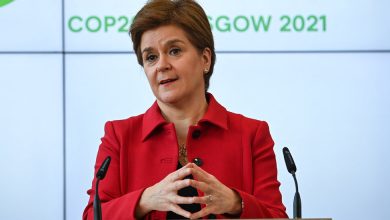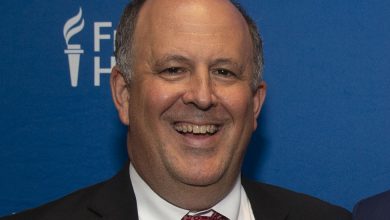Fed officials discussed raising rates sooner and faster in 2022.

Federal Reserve officials deliberated the path ahead for interest rates at their December meeting, suggesting that they may need to remove their support for the economy more quickly than they had previously expected at a moment of high inflation and rampant uncertainty.
Central bankers projected that they would raise interest rates three times in 2022, the economic estimates they released following their Dec. 14-15 meeting showed. Economists and investors think that those increases could begin as soon as March, which is when the central bank is now expected to wrap up its large-scale bond buying program.
Given their outlooks for growth, the labor market and inflation, the Fed officials noted that “it may become warranted to increase the federal funds rate sooner or at a faster pace than participants had earlier anticipated,” according to the minutes, which were released Wednesday.
The Fed’s big asset purchases had been adding juice to the economy and markets with each passing month, so cutting them off will give the economy less momentum. Raising interest rates would do more to actually slow growth: By making borrowing costs for houses, cares and credit cards more expensive, higher rates should slow spending, weighing on investment and eventually holding back hiring and tamping down prices.
The Fed faces trade-offs as it contemplates the path ahead. Higher interest rates could weaken a job market that is still healing following 2020 pandemic lockdowns. But if the Fed waits too long or moves too slowly, businesses and consumers could begin to adjust their behavior to the very high inflation that has dogged the economy over much of the past year. That could make it harder to bring price gains back under control — forcing more drastic, and potentially even recession-causing, rate increases down the road.
What to Know About Inflation in the U.S.
- Inflation, Explained: What is inflation, why is it up and whom does it hurt? We answered some common questions.
- The Fed’s Pivot: Jerome Powell’s abrupt change of course moved the central bank into inflation-fighting mode.
- Fastest Inflation in Decades: The Consumer Price Index rose 6.8 percent in November from a year earlier, its sharpest increase since 1982.
- Why Washington Is Worried: Policymakers are acknowledging that price increases have been proving more persistent than expected.
- The Psychology of Inflation: Americans are flush with cash and jobs, but they also think the economy is awful.
The minutes showed that both considerations weighed on policymakers’ minds as they considered their future actions, but as the labor market healed swiftly, they were turning their attention to the threat of too-high inflation.
“Several participants remarked that they viewed labor market conditions as already largely consistent with maximum employment,” the minutes said.
Officials might begin to promptly shrink their balance sheet — where the bonds they bought are held — further removing support from the economy.
“Some participants also noted that it could be appropriate to begin to reduce the size of the Federal Reserve’s balance sheet relatively soon after beginning to raise the federal funds rate,” the minutes stated.
There’s a reason for the Fed’s active stance. Inflation has been alarmingly high for much longer than central bankers had expected. Last year, policymakers expected prices to pop temporarily as pandemic-affected sectors like airlines and restaurants recovered, then return to normal.
Instead, prices climbed by the most since 1982 in the year through November, and monthly gains remained brisk. Factory shutdowns and tangled shipping lines have made it hard for suppliers to catch up with booming consumer demand for goods, forcing costs up. Price gains have also begun to spread: Rents are increasing more quickly, which could make high inflation more persistent.
Inflation is broadly expected to fade this spring, as prices are measured against relatively high levels from a year earlier. Prices may also decelerate as producers catch up with demand, officials hope. But policymakers lack certainty about when that will happen.
Officials projected in their December economic estimates that inflation will ease to 2.6 percent by the end of 2022, but estimates ranged from 2 percent to 3.2 percent. To put those numbers into context, the Fed’s preferred price index climbed by 5.7 percent through November, and the central bank targets 2 percent annual gains on average over time.
Inflation F.A.Q.
What is inflation? Inflation is a loss of purchasing power over time, meaning your dollar will not go as far tomorrow as it did today. It is typically expressed as the annual change in prices for everyday goods and services such as food, furniture, apparel, transportation costs and toys.
What causes inflation? It can be the result of rising consumer demand. But inflation can also rise and fall based on developments that have little to do with economic conditions, such as limited oil production and supply chain problems.
Where is inflation headed? Officials say they do not yet see evidence that rapid inflation is turning into a permanent feature of the economic landscape, even as prices rise very quickly. There are plenty of reasons to believe the price burst will fade, but some concerning signs suggest it could last.
Is inflation bad? It depends on the circumstances. Fast price increases spell trouble, but moderate price gains could also lead to higher wages and job growth.
How does inflation affect the poor? Inflation can be especially hard to shoulder for poor households because they spend a bigger chunk of their budgets on necessities — food, housing and especially gas.
Can inflation affect the stock market? Rapid inflation typically spells trouble for stocks. Financial assets in general have historically fared badly during inflation booms, while tangible assets like houses have held their value better.
Explaining their forecasts for more lasting high inflation, “participants pointed to rising housing costs and rents, more widespread wage growth driven by labor shortages, and more prolonged global supply-side frictions, which could be exacerbated by the emergence of the Omicron variant,” the minutes said.
Officials have adapted their policy rapidly over the past few months as inflation stirs unease. They announced that they would slow bond purchases, then promptly doubled the pace of that process. They went from signaling that they might or might not raise interest rates in 2022 to making it clear that they plan to do so.
The question is what will come next: Will the central bank need to accelerate its plans to pull back stimulus further? Or will inflation fade enough on its own that an aggressive central bank response will prove unnecessary?
Investors will also be watching closely to see how the Fed’s actions affect stock and other asset prices, which tend to benefit from bond buying and low rates. There’s an adage that the Fed’s job is to take away the punch bowl just as the party gets going — and that is what it is gearing up to do.
Markets “have gotten used to not just a punch bowl, but a spiked punch bowl,” said Nela Richardson, chief economist at ADP.
The new virus variant, which could also slow hiring and growth, is also looming over the outlook.
“Many participants noted that the emergence of the Omicron variant made the economic outlook more uncertain,” the minutes said.



